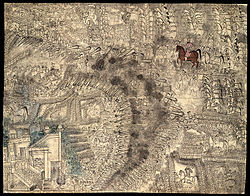
Back احمد شاہ درانی دیاں ہندوستان اُتے لشکری مہماں PNB پر هند د احمد شاه بابا لښکرکشي Pashto/Pushto احمد شاہ درانی کی ہندوستان پر لشکری مہمات Urdu
This article has multiple issues. Please help improve it or discuss these issues on the talk page. (Learn how and when to remove these messages)
|
The Indian Campaign of Ahmad Shah Durrani (1748–1769) was a series of invasions by the ruler of the Durrani Empire, Ahmad Shah Durrani against the declining Mughal Empire, the Maratha Confederacy, Sikh Confederacy and numerous other Indian kingdoms. The primary basis of the invasions originated after the political independence of the Afghan Empire following the end of the Naderian Wars and persisted until his last invasion in 1769.
Ahmad Shah led a total nine punishing invasions into India between 1748 and 1769. His objectives were met through the raids (taking the wealth and destroying sacred places belonging to the Indians) and deepening the political crisis in India.[1][2][3][4] Of the invasions, the most significant attacks were in 1757 and 1761; sacking the city of Delhi in 1757, and defeating the Maratha confederacy at the decisive Third Battle of Panipat. His later invasions focused on conflicts with the Sikhs and stability of Durrani domains in the Punjab.
- ^ Singh, Kulwant (15 July 2012). "Society - Raiding the raiders -Sikhs warriors of the 18th century adopted guerrilla tactics. They offered tough resistance to the invading Afghan armies of Nadir Shah and Ahmed Shah Abdali by looting them and freeing those enslaved by them". The Sunday Tribune - Spectrum (www.tribuneindia.com). Retrieved 4 December 2020.
- ^ Betts, Vanessa; Victoria McCulloch (2013). India: The North. Bath, UK: Footprint. p. 146. ISBN 978-1-907263-74-3. OCLC 881063949.
- ^ Bansal, Bobby Singh (2015). "Chapter 5 - North-West Frontier". Remnants of the Sikh empire: historical Sikh monuments in India and Pakistan. New Delhi: Hay House Publishers India. ISBN 978-93-84544-89-8. OCLC 934672669.
- ^ Tom Lansford, ed. (2017). Afghanistan at War: From the 18th-century Durrani Dynasty to the 21st Century. Santa Barbara, California: ABC-CLIO. p. 21. ISBN 978-1-59884-759-8. OCLC 952980822.
© MMXXIII Rich X Search. We shall prevail. All rights reserved. Rich X Search



